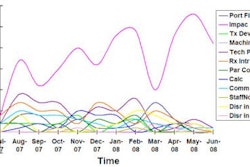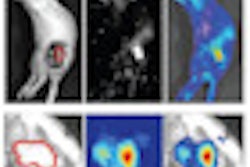
Quality assurance (QA) of intensity-modulated radiation therapy (IMRT) is a vital component in the radiotherapy process, but current QA procedures are far from optimal. Log files produced by radiotherapy systems can be exploited to vastly improve IMRT quality assurance.
Attendees at a symposium held during the American Association of Physicists in Medicine (AAPM) meeting in Charlotte, NC, in August learned about the value of log files as part of the QA process. The symposium was sponsored by radiation therapy quality assurance company Modus Medical Devices of London, Ontario.
A few years ago, when questioned as to whether all radiotherapy patients were being treated correctly, Dr. Sasa Mutic, PhD, said he could only reply, "We don't know." Mutic is director of clinical medical physics and professor of radiation oncology at Mallinckrodt Institute of Radiology at Washington University School of Medicine.
Mutic described how the Washington University team addressed this problem. He began by citing a study that used 4,407 event reports (errors and near misses) from two hospitals to assess which QA checks are most likely to catch errors.
The most effective checks included physics chart review, which provided a sensitivity of more than 60%, followed by therapy chart review, physics weekly chart check, physician chart review, and electronic portal imaging device (EPID) dosimetry. Pretreatment IMRT QA, however, was the worst performer, with a sensitivity of just a few percent. "Nothing was less effective than pretreatment IMRT QA," said Mutic.
Improving QA
So why is IMRT QA so bad? Mutic suggested several underlying reasons. For starters, pretreatment verification of data transfer is currently performed manually, resulting in a high chance of human error. It's also standard practice to perform pretreatment phantom-based dose measurements, which can only demonstrate that it's possible to correctly treat a phantom at a particular point in time.
Other issues include unsystematic manual verification of on-treatment data, minimal to zero use of statistical analysis tools, and the fact that QA data are examined individually, without comparison with past performance.
"As delivery systems and software have advanced, hardly anybody has really considered whether the original QA paradigms are still appropriate," Mutic explained.
An ideal system for IMRT QA and quality control (QC) should be based on actual requirements, not just on the available technology, Mutic said. It should be automated, fast, intelligent, and inexpensive. With these aims in mind, Washington University has implemented an automated QA/QC system that uses a suite of tools to perform checks at all stages throughout the treatment process.
Automated precheck scripts assess the validity and quality of the treatment plan, and data transfer is also checked automatically. "We have software that will automatically check charts," said Mutic. "The aim is not to eliminate the physicists; these processes run in parallel and help us." Pretreatment QA is also automated, and all collected data are stored in a database for future benchmarking.
The final stage in this process is automated Dynalog quality assurance, or ADQ. ADQ automatically analyses the dynamic machine log files (called Dynalog files on the system from Varian Medical Systems) produced routinely by the linac during IMRT, and compares these to the treatment plan. Importantly, it does this for each patient, each treatment session, and each beam. The software then creates QA reports and records any problems in a database, automatically emailing physicists if any major problems are found.
ADQ improves upon existing daily QA procedures as it is used for every single routine and is fully automated, running in the background and requiring no data other than that produced through routine processes. ADQ does not require any additional hardware and can provide independent verification of any measurement-based technique.
Mutic described a study in which 912 Dynalog QA analyses were performed over approximately 18 months. Of these, 14 errors that caused dosimetric deviation were detected, including, for example, plan errors, data transfer errors, data corruption, machine problem, and unintentional data changes.
"We think that ADQ is so inexpensive and so easy, it doesn't matter what other QA procedures you employ, it's easy to have this running in the background," he concluded. "It's so simple; I'm surprised more people aren't using it."
What's the delivered dose?
If the ADQ process does detect any errors in treatment delivery, it's important to assess the resulting dosimetric impact. Log files can also prove valuable here, as explained by the symposium's second speaker, Lei Xing, PhD, director of the physics division at Stanford School of Medicine.
"Currently, IMRT/VMAT [volumetric-modulated arc therapy] QA is an open-loop process," said Xing. "We need a technique that will allow us to answer the question: 'What is the dose delivered to the patient?' and close this loop."
This is where log files come in. Log files can be used to reconstruct the delivered fluence map. The dose distribution delivered to the patient can then be calculated using this fluence map with a patient model derived from a pretreatment conebeam CT. This enables comparison of the dose distribution and dose-volume histograms with those of the original treatment plan.
This approach can also be used to simplify patient-specific QA of IMRT and VMAT. One option is to use a cylindrical phantom, such as Modus' Quality Assurance System for Advanced Radiotherapy (QUASAR) verification phantom, for example, with an ion chamber placed inside. Ion chamber measurements performed while delivering the treatment plan to the phantom provide one or more point dose measurements. The dynamic log files are then retrieved, enabling reconstruction of the 3D dose distribution. The QA report is generated by combining the point dose measurements and the reconstructed 3D dose distribution.
Xing notes that the entire process takes just five minutes. It is suitable for use with high-dose-rate flattening filter-free beams, which can be problematic for other QA regimes.
"Patient-specific QA can be very labor intensive; measurements take a lot of time," he explained. "Every clinic makes its own decision as to what to measure and to what extent. The combined point measurement and dose reconstruction approach is more comprehensive, cost-effective, and robust than any other measurement being performed today. The technique promises to revolutionize the way that current patient-specific IMRT/VMAT QA is being done and greatly facilitate the clinical workflow."
© IOP Publishing Limited. Republished with permission from medicalphysicsweb, a community website covering fundamental research and emerging technologies in medical imaging and radiation therapy.



















